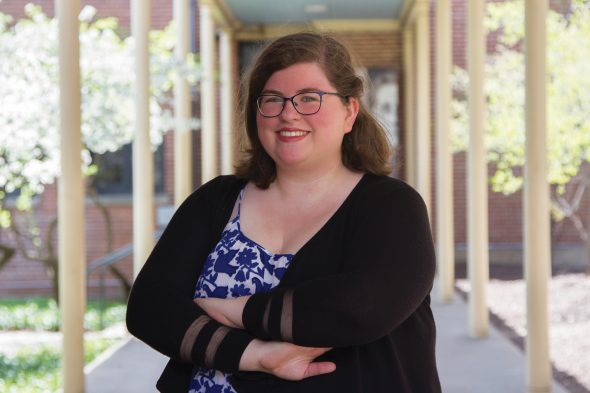East Meets West: Making museums accessible for all

Recent UIC alum Courtney Sass collaborated with campus researchers to create a Museum Accessibility Toolkit. Photo: Vibhu S. Rangavasan
East Meets West is a collaboration of Provost Susan Poser and Vice Chancellor for Health Affairs Robert Barish.
UIC graduate Courtney Sass loves museums, so it seemed only natural to dedicate her thesis research to making sure everyone has a chance to enjoy them.
“I want more people to go and feel comfortable in museums,” said Sass, who completed her master’s degree in museum and exhibition studies in 2016. “I think feeling comfortable is a factor to enjoying something.”
Sass developed the Museum Accessibility Toolkit — an online resource to help museums and galleries create a more welcoming environment for people who have disabilities.
“There are so many ways that you can accommodate people,” Sass said. “I’m constantly learning.”
To include the best possible information and research in the toolkit, Sass took a multidisciplinary approach. For her research, she teamed up with Therese Quinn, director of museum and exhibition studies in the School of Art & Art History, and Carrie Sandahl, associate professor of disability and human development in the College of Applied Health Sciences.
“Carrie was very good at making me consider the language that I used,” Sass said. “She said, ‘As passionate as you are about this, you have to make it an exciting challenge for people.’ She made sure I had the right approach to drawing people in.
“Therese helped me with thinking about practical concerns. She’s got a lot of experience in museums, so she really helped me keep in mind that a lot of museums maybe don’t have a big budget to do this, so to try to make it as inexpensive as possible.”
The result was a well-rounded guide that can be applied in museums and galleries all over the world.
“To my knowledge, most of these museums are not thinking broadly about the full scope of disabilities and how to be as fully accessible as possible,” Quinn said. “So, Courtney’s work is really valuable in that regard because she pulled together many resources that museums can draw on to use as a toolkit for helping their institutions think about full access.”
Committed to creating more accessible museums for all, Sass decided to make the toolkit available for free.
“The goal is to make it as easy as possible for museums of any size or galleries of any size to implement these programs,” she said. “I really wanted to make it as easy as possible for people to access it.”
Having the ability to collaborate with faculty from both the east and west sides of campus provides an outlet for students like Sass to create research that impacts people’s everyday lives, Quinn said.
“We’re really lucky to be at a university that has all those resources to draw on,” said Quinn, associate professor of art history. “I think that’s one of the selling points of our program. When applicants apply to our program, what many of them say is that they’re excited about is the opportunity to study across the university with faculty in different areas to help round out their focus.”
The work isn’t done for Sass, though. Although she has graduated from UIC, she is still perfecting the Museum Accessibility Toolkit.
“I really commend Courtney,” Quinn said. “She didn’t just file it in the library and go on to do the next thing. She kept working on ways to make it available because she really believes that it’s so important. It’s a social justice mission.”
